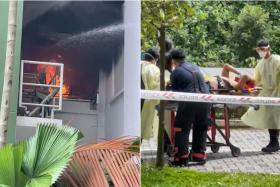Exposed LPG pipe, lack of preparedness led to fatal Jalan Buroh fire
Workers were also not familiar with what to do in an emergency: MOM report
To allow more liquefied petroleum gas (LPG) cylinders to be filled at a time, a company made modifications some years ago, increasing the number of filling stations from eight to 12.
But exposed small-bore pipelines that supplied the LPG were not protected from impact.
All it took was a toppled cylinder dislodging one of the pipes to set Summit Gas Systems' bottling and storage facility ablaze.
It was the largest LPG fire the Singapore Civil Defence Force (SCDF) had to battle. The inferno at the Jalan Buroh site on June 21 last year killed a 43-year-old worker, injured two others and took about 120 firefighters more than two hours to bring under control.
Detailing the events that led to the fire in a learning report published yesterday, the Ministry of Manpower (MOM) shared recommendations it hopes other companies using small-bore pipelines can adopt.
MOM said Summit Gas, a subsidiary of Union Energy, had used a semi-automated system to fill large LPG cylinders.
Pneumatic stoppers held empty LPG cylinders in a queue on the conveyor while a pneumatic arm would feed the cylinders into the rotating carousel.
Once filled, the cylinders would be ejected back onto the conveyor and moved to storage.
The three workers in the incident were required to manually connect and disconnect filling heads to each cylinder.
Before the fire, a pneumatic stopper had malfunctioned, causing the empty cylinders to collide against each other and the cylinder at the front of the queue to become misaligned.
The first cylinder fell into a gap between two filling stations and hit the small-bore pipeline. This dislodged the pipe and released LPG that ignited.
The report did not specify the source of ignition, but an MOM spokesman said it was likely an electric or static charge.
The three workers, who were not wearing fire retardant clothing, fled the area but found their escape route blocked by cylinders placed around the vicinity.
The emergency shutdown button that could stop the supply of LPG was at the other end of the shed the workers were in, and no one was nearby to activate it.
This meant LPG continued to flow after the pipe was dislodged, further fuelling the fire.
The report stated: "Workers were not familiar with the actions to be taken in the event of an emergency."
This is the first learning report to be published since the framework was introduced in 2018, allowing MOM to share case facts on major complex accidents without waiting for criminal proceedings to conclude, which could take as long as three years from the date of the accident.
They also do not state liability and are not admissible in court.
For the Summit Gas fire, MOM is continuing investigations to establish the responsibilities of the parties involved. The company is rebuilding its Jalan Buroh plant with MOM's help.
Get The New Paper on your phone with the free TNP app. Download from the Apple App Store or Google Play Store now



